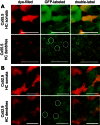Specific connectivity between photoreceptors and horizontal cells in the zebrafish retina
- PMID: 27707811
- PMCID: PMC5155036
- DOI: 10.1152/jn.00449.2016
Specific connectivity between photoreceptors and horizontal cells in the zebrafish retina
Abstract
The functional and morphological connectivity between various horizontal cell (HC) types (H1, H2, H3, and H4) and photoreceptors was studied in zebrafish retina. Since HCs are strongly coupled by gap junctions and feedback from HCs to photoreceptors depends strongly on connexin (Cx) hemichannels, we characterized the various HC Cxs (Cx52.6, Cx52.7, Cx52.9, and Cx55.5) in Xenopus oocytes. All Cxs formed hemichannels that were conducting at physiological membrane potentials. The Cx hemichannels differed in kinetic properties and voltage dependence, allowing for specific tuning of the coupling of HCs and the feedback signal from HCs to cones. The morphological connectivity between HC layers and cones was determined next. We used zebrafish expressing green fluorescent protein under the control of Cx promoters. We found that all HCs showed Cx55.5 promoter activity. Cx52.7 promoter activity was exclusively present in H4 cells, while Cx52.9 promoter activity occurred only in H1 cells. Cx52.6 promoter activity was present in H4 cells and in the ventral quadrant of the retina also in H1 cells. Finally, we determined the spectral sensitivities of the HC layers. Three response types were found. Monophasic responses were generated by HCs that contacted all cones (H1 cells), biphasic responses were generated by HCs that contacted M, S, and UV cones (H2 cells), and triphasic responses were generated by HCs that contacted either S and UV cones (H3 cells) or rods and UV cones (H4 cells). Electron microscopy confirms that H4 cells innervate cones. This indicates that rod-driven HCs process spectral information during photopic and luminance information during scotopic conditions.
Keywords: connexins; horizontal cell; photoreceptors; retina; zebrafish.
Copyright © 2016 the American Physiological Society.
Figures









Similar articles
-
Retinal horizontal cell-specific promoter activity and protein expression of zebrafish connexin 52.6 and connexin 55.5.J Comp Neurol. 2007 Apr 10;501(5):765-79. doi: 10.1002/cne.21282. J Comp Neurol. 2007. PMID: 17299759
-
Physiological and molecular characterization of connexin hemichannels in zebrafish retinal horizontal cells.J Neurophysiol. 2012 May;107(10):2624-32. doi: 10.1152/jn.01126.2011. Epub 2012 Feb 22. J Neurophysiol. 2012. PMID: 22357795 Free PMC article.
-
Specificity of the horizontal cell-photoreceptor connections in the zebrafish (Danio rerio) retina.J Comp Neurol. 2009 Oct 10;516(5):442-53. doi: 10.1002/cne.22135. J Comp Neurol. 2009. PMID: 19655401 Free PMC article.
-
Connexin hemichannel mediated ephaptic inhibition in the retina.Brain Res. 2012 Dec 3;1487:25-38. doi: 10.1016/j.brainres.2012.04.059. Epub 2012 Jul 13. Brain Res. 2012. PMID: 22796289 Review.
-
Structure and function of photoreceptor and second-order cell mosaics in the retina of Xenopus.Int Rev Cytol. 2001;210:77-120. doi: 10.1016/s0074-7696(01)10004-5. Int Rev Cytol. 2001. PMID: 11580209 Review.
Cited by
-
Zebrafish Retinal Ganglion Cells Asymmetrically Encode Spectral and Temporal Information across Visual Space.Curr Biol. 2020 Aug 3;30(15):2927-2942.e7. doi: 10.1016/j.cub.2020.05.055. Epub 2020 Jun 11. Curr Biol. 2020. PMID: 32531283 Free PMC article.
-
Leveraging Zebrafish to Study Retinal Degenerations.Front Cell Dev Biol. 2018 Sep 19;6:110. doi: 10.3389/fcell.2018.00110. eCollection 2018. Front Cell Dev Biol. 2018. PMID: 30283779 Free PMC article. Review.
-
Ancestral circuits for vertebrate color vision emerge at the first retinal synapse.Sci Adv. 2021 Oct 15;7(42):eabj6815. doi: 10.1126/sciadv.abj6815. Epub 2021 Oct 13. Sci Adv. 2021. PMID: 34644120 Free PMC article.
-
tet2 and tet3 regulate cell fate specification and differentiation events during retinal development.bioRxiv [Preprint]. 2024 Dec 10:2024.12.06.627071. doi: 10.1101/2024.12.06.627071. bioRxiv. 2024. Update in: Sci Rep. 2025 Mar 26;15(1):10404. doi: 10.1038/s41598-025-93825-5. PMID: 39713311 Free PMC article. Updated. Preprint.
-
Ancestral photoreceptor diversity as the basis of visual behaviour.Nat Ecol Evol. 2024 Mar;8(3):374-386. doi: 10.1038/s41559-023-02291-7. Epub 2024 Jan 22. Nat Ecol Evol. 2024. PMID: 38253752 Review.
References
-
- Atick JJ, Li Z, Redlich AN. Understanding retinal color coding from first principles. Vision Res 4: 559–572, 1992.
-
- Chalupa LM, Werner JS. The Visual Neurosciences. Cambridge, MA: MIT Press, 2003.
-
- Ciolofan C, Lynn BD, Wellershaus K, Willecke K, Nagy JI. Spatial relationships of connexin36, connexin57 and zonula occludens-1 in the outer plexiform layer of mouse retina. Neuroscience 148: 473–488, 2007. - PubMed
Publication types
MeSH terms
Substances
LinkOut - more resources
Full Text Sources
Other Literature Sources
Molecular Biology Databases
Miscellaneous

